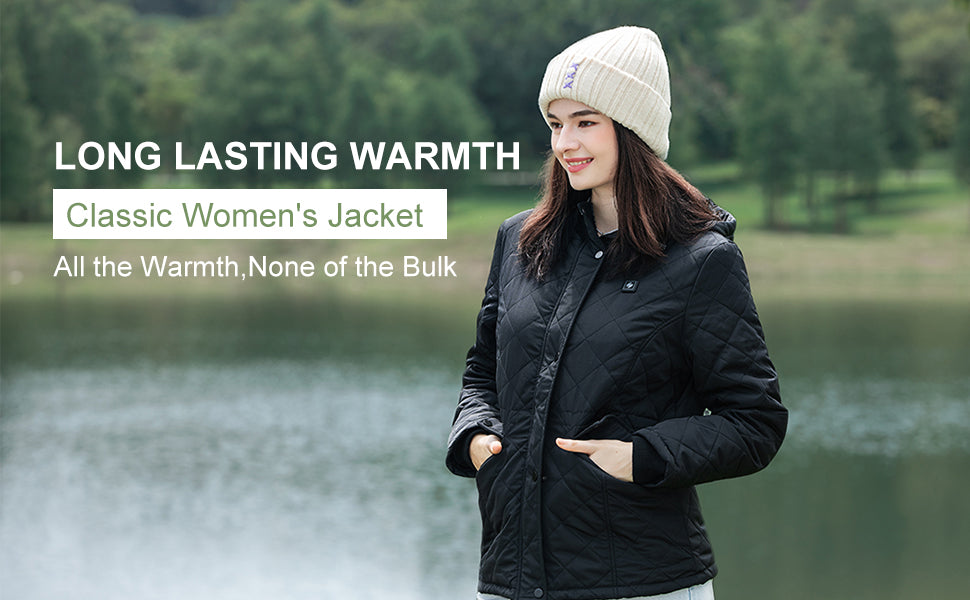Can You Wear a Heated Vest with a Pacemaker?

Heart conditions are prevalent in individuals nowadays. Bradycardia and atrial fibrillation are two of the more serious issues which are countered by the evolution of pacemakers. Observing a recent survey, it is seen that Over 1 Million pacemakers are being used to regular serious heart conditions.
As a safety measure, to keep oneself warm, many people use the layering technique to stay warm in freezing temperatures. However, with rising technology the majority population has shifted towards the use of heated apparel. Heated vests in popular demand. But this can impact the functioning of people with pacemakers regulating their heart disorders.
In rare cases, the EMI generated by the electronic components in a heated vest can interfere with the working of pacemakers. Keeping this aside, heated vests are lauded due to their extensive use in cold weathers. They utilize ultra-modern technology, but care is recommended when used with a pacemaker.
To counter this, getting a heated vest from a vetted manufacturer of heated apparel such as SGKOW, is a premium choice. Different safety features such as low EMI emission and EMI shielding are seen in this to protect from the effects. Weather-resistance and durability are two more features that make this brand’s apparel top of the line.
This makes it the perfect fit for harsh weather conditions and northern areas. Discussing further in this article, we will elaborate the effect of a heated vest on a pacemaker and how to avoid or neutralize its effects easily.
Understanding Pacemakers
Helping control the heart rhythm pacemakers are employed. These are small power sources that are surgically placed below the collarbone in an individual’s chest cavity. Along with solving many other disorders, Bradycardia patients can get maximum use out of this.
This term is characterized by the excessive slow heart rate of an individual which is regulated by a pacemaker. Individuals facing ventricular blockage also see maximum effects from this.
Rundown of Pacemaker and its Workability
There are two main parts of a pacemaker. These consist of an electrical pulse generator and electrical leads. When talking about the pulse generator, it is an electrically operated device. Along with a heated vest battery, this is present in a compact metal casing.
Thin metal wires create the electrical leads within a pacemaker. A medical professional surgically placed these leads inside the patient’s heart to coordinate it with the pacemaker’s pulse generator. Through electrical impulses generated a person’s heartbeat can be monitored and streamlined with the pulse generator. In case of slow pumping, the pulse generator sends a regulated voltage signal.
The electrical leads are implanted to constantly observe the activity of the heart. Heart’s impulses can thus be monitored. This tool picks up the signals produced by the heart’s impulses. These are typically in the form of P-wave and R-wave coming from the heart’s atria and ventricles.
Now comes the functioning of the electrical leads. These help carry the signals created by the pulse generator to the heart. The medical professional placing the pacemaker in a person’s heart can pre-determine and set the fixed signal rate. The pacemaker can thus monitor the person’s natural heart rhythm and pace accordingly to create a normal heart beat.
For people with high activity levels, these pacemakers can be programmed to raise the rate of pacing. This can be modified according to their physical activity and demands.
Significance of Prevent Electromagnetic Interference With Pacemakers
Malfunctioning of pacemakers is a critical effect of Electromagnetic Fields. These indirectly affect the normal functioning of the heart. Due to this, the steady pacing of the pacemaker is interrupted. It may result in drastic effects because it raises the risk of heart-related complications.
It can hinder the pacemaker’s ability to monitor and regulate the heart’s rhythm. False alarms are a direct outcome of this electromagnetic interference. Various parts of the pacemaker are also affected by this directly. Battery drainage is something that can be observed due to this.
Maintaining a safe distance is a first call with the equipment that can potentially generate EMIs. When focusing on utilizing heated vests, looking for brands that offer safety in case of EMIs is key. SGKOW’s heated vests comply with this as they have set safety standards like low EMI emission in their apparel.
Heated Vests: A Brief Overview
Lightweight and durable heated vests come with built-in heating components. Lithium-ion batteries are their power source. Breathable fabrics such as Polyester are also a part of their composition. They are versatile in use and this has made their demand grow significantly. It can easily be worn over the clothes.
The Functioning Technology Behind Heated Vests
Heat generation and heat distribution are two phenomenons that are actively followed in heated vests. Advanced technological features help achieve this in these heated vests. The key elements of these vests are heating components. These can either be composed of carbon fiber or a metal compound such as Nickel-Chromium. These help generate heat within the vest.
Power is sourced from rechargeable Lithium-ion batteries or USB-powered resources in heated vests. After the vest is turned on, the batteries create an electric current. This current then moves along the heating components to warm them up. In this aspect, SGKOW comes with a Unisex Heated Vest. This vest contains a rechargeable battery of 5V/2A of 1000mAh.
With its 4-8 hour consistent heat provision, this is an excellent choice. Generally on the upper portion of the chest area in the heated vest, there is a temperature settings regulator. Through this, the individual can easily modify heat output accordingly.
With having a breathable material in the composition of the vest, this material helps in transferring the heat to the individual’s body. However, the material also is comfortable enough to prevent overheating.
Popular Uses and Benefits
Consistent Warmth
- Equal heat dispersion is a property well-suited with heated vests. Insulation is provided through this to counter chilly conditions. It helps keep the body of the individual warm and athletes or other people interested in outdoor activities can make use of it.
- Comfort is another factor provided by heated vests. It relaxes the body of the wearer making them focus easily on their tasks. Shivering and excessive cold can be controlled by these.
Therapeutic Effects
- Arthritis, fibromyalgia and other chronic conditions are common in people nowadays. A heated vest helps relieve the joint pain and other discomfort associated with these disorders.
- Hypothermia can be fatal If not prevented. It refers to an abnormally low basal body temperature. By regulating heat, heated vests can provide optimum warmth in times of need and insulation against external cold.
- The level of endorphins is greatly enhanced by incorporating the use of heated vests. These endorphins can alleviate the mood and pain of an individual effectively.
- Muscle pain is also a common effect of freezing weather. Body circulation can be enhanced by wearing a heated vest. Once the circulation is increased it can relieve the tension in the muscles and cause them to relax.
Energy-Efficient
- Low power consumption is a big plus of heated vests. Along with producing a large amount of heat they help conserve large amounts of energy.
- Through design, the heating components within a heated vest are employed to disperse uniform heat. This prevents the requirement of energy to heat up every area. It does not drain the battery as a result and can run up to longer periods of time. Thus, it is energy efficient.
- It also is energy efficient, because it’s made up of insulating materials. These retain body heat as well as heated vest generated heat effectively.
Risks Associated with Using Heated Vests and Pacemakers
How Heated Vests Might Produce EMI
There is a significant level of EMI generation by heated vests due to the presence of electrical components within it. However, to reduce the EMI generation, usually the batteries of these vests are specifically designed. But there is still a possibility of some. The computerized control settings and microprocessors in the system of the heated vest can create electromagnetic radiation. However, keeping all this in mind, still heated vests do not produce intense EMIs.
Real-life Cases or Studies Showing the Effects of Heated Vests on Pacemakers
Research Studies
There are a few research cases that let the experts examine the interaction of heated vests with pacemakers. With extensive evaluation, it shows that however, heated vests are safe to use with pacemakers.
- A small group pf people with pacemakers were examined in 2015 to see how they responded to using heated vests. Their research was published in Heart Rhythm. The findings indicate that the use of heated vests does not interfere with the workings of pacemakers.
- Another study from 2016 investigated the effects of heated vests on the heart rates and blood pressure of persons who use pacemakers. Neither the pulse rate nor the blood pressure of those who wore heated vests was shown to rise.
Safe usage of heated vests with pacemakers is elaborated by these researches. Physician’s directions are however advised to anyone using a pacemaker for wearing a heated vest.
Real-Life Cases
- A case study was Published in the Journal of Heart Rhythm. In this case study, a 77-year-old man with a pacemaker by the use of a heated vest experienced lightheadedness and nausea. Prolonged exposure caused this effect. The signs went away once the individual stopped wearing the heated vest.
- Another case study was Published in Pacing and Clinical Electrophysiology. In this case, a 65-year-old lady suffered from palpitations and chest discomfort with a pacemaker after using a heated vest. This was caused after several hours of use of a heated vest. These symptoms resolved after she removed the heated vest.
Safety Precautions
- Manufacturer’s guidelines elaborate to keep a safe distance between a heated vest and a pacemaker. SGKOW is top-notch as it has low EMI emission. Safety guidelines are also provided with the heated vest for the convenience of the user.
- Heating components affect the EMI emissions a lot. Carbon-fiber as a heating component is the best choice in this regard. Choosing this cab lowers the EMI and keeps the interference with the pacemaker away.
- One heating component is enough to prevent high-intensity EMIs. Multi-heating components vests are capable of generating more EMI which is higher than the EMI of a single heating component.
- Additional layer of clothing is advised with a pacemaker. You can wear the heat over it to avoid direct contact with the pacemaker.
- Keep a check on the health conditions to counter any effects of EMI interference with the pacemaker.
Alternative Solutions for Those with Pacemakers
Non-Electric Warming Options
If the individual wants to avoid using a pacemaker, he can revert to other forms of warming the body except heating vests. Some of these are elaborated below.
Heated Blankets
A variety of heat levels are offered with electrical heated blankets. These may be particularly useful in the evenings. Adjusting the temperature to body requirements is easy with these.
Heating Pads
There are some areas where sometimes an individual requires more warmth. Target areas can be back, neck and shoulders. Electric heating pads come in handy in this regard. These also come with many temperature settings to adjust to body and weather requirements.
Heated Gloves
Portable gloves which run by an electric power source are highly portable. Individuals can easily carry these in their pockets. They can provide heat to keep the hands of the individual warm.
Microwavable Thermal Pads
Hands, feet and other body parts sometimes need to be warmed in order to get comfortable. In this case, microwavable thermal pads can be used. These can be heated by placing them in the microwave. They contain a gel or other substance that can be microwaved without any harm. These can then be applied to the required area.
Wearing Layers
For the individuals, generally with a pacemaker that want to avoid heating equipment, layering up is ideal. Layers of clothes can be worn to insulate the body from outside cold.
Concluding Note
Pacemakers are equipment that help enhance the quality of life for people with heart conditions. Having low electromagnetic interference, heated vests can be used with a pacemaker. Safety guidelines and low EMI provisionsprovisions come with SGKOW’s reliable heated vests. It is also recommended to consult a cardiologist or general physician before using a heated vest. We hope this article was of maximum help to you.





















Leave a comment